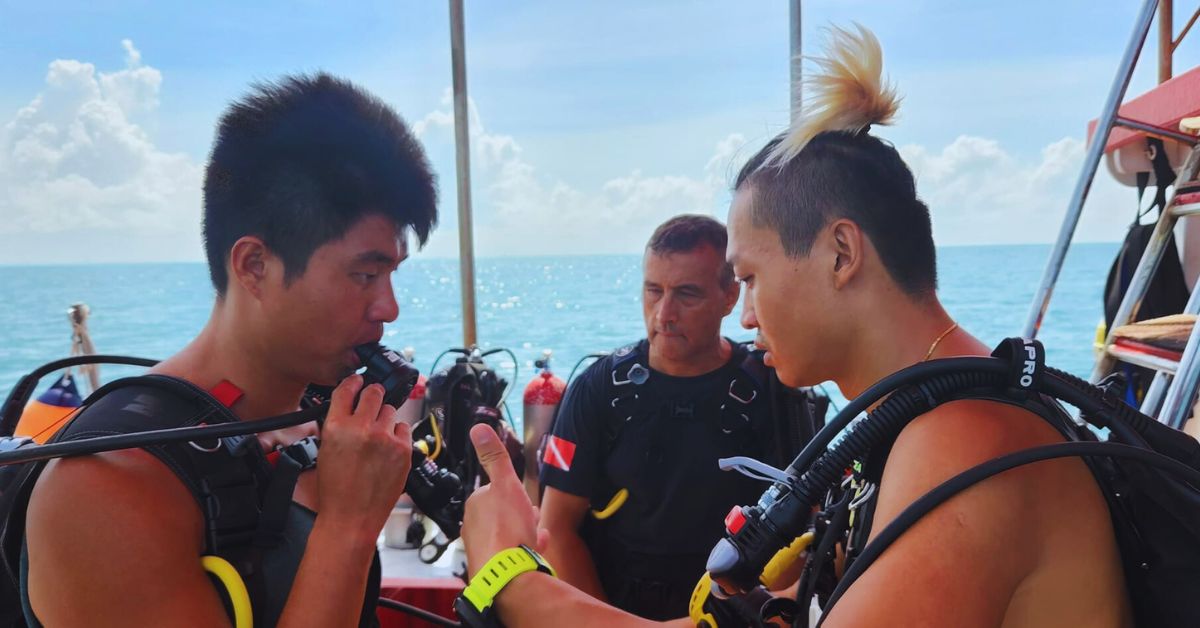Master the Essential Safety Tips Every Diver Must Know
Diving is an exhilarating experience that connects you to the wonders of the underwater world. However, safety is the cornerstone of every successful dive. Understanding essential safety tips every diver should know is crucial for avoiding risks and enhancing enjoyment. From mastering buddy checks to practicing proper ascent rates, these guidelines ensure that you’re prepared for every situation, making each dive unforgettable for all the right reasons.
The Importance of Pre-Dive Buddy Checks
A key component of the Essential Safety Tips Every Diver Should Know is mastering pre-dive buddy checks. These checks ensure that your equipment and your buddy’s setup are functioning perfectly. Skipping this critical step increases the risk of equipment-related mishaps, which can disrupt an otherwise amazing dive.
What Are Buddy Checks?
Buddy checks are an essential pre-dive practice where you and your diving partner systematically inspect each other’s gear and readiness. This step ensures your equipment is functioning properly, aligns your plans with your buddy’s, and prepares both of you for potential emergencies. Think of it as a shared safety net—what you might miss, your buddy could catch, and vice versa.
Why Are Buddy Checks Critical?
- Prevention of Equipment Failures: Even small issues, like a slightly closed air tank or an improperly secured weight belt, can lead to significant problems underwater.
- Fostering Communication and Trust: Buddy checks help establish clear communication and align your dive plans, reducing misunderstandings during the dive.
- Emergency Preparedness: Familiarizing yourself with your buddy’s gear makes it easier to assist them in emergencies, such as an out-of-air situation.
How to Perform a Buddy Check Effectively
Buddy checks are best performed using the BWRAF method, which ensures no aspect of safety is overlooked:
B – BCD (Buoyancy Control Device):
- Inflate and deflate your buddy’s BCD to confirm it functions correctly.
- Check for leaks, tears, or loose connections in the inflator hose.
- Ensure the BCD fits snugly without restricting movement.
W – Weights:
- Confirm that weights are securely fastened and evenly distributed.
- Test the weight release mechanism to ensure it works smoothly and can be operated by either diver in an emergency.
R – Releases:
- Inspect all buckles, clips, and straps to ensure they are secure and accessible.
- Familiarize yourself with the locations of releases to assist your buddy if needed.
A – Air:
- Confirm the air tank is turned on fully and the regulator provides clean, consistent airflow.
- Check the air pressure gauge to ensure there’s enough air for the planned dive.
- Test the alternate air source (octopus) to ensure it’s functioning properly.
F – Final Check:
- Conduct a visual sweep of your buddy’s setup for loose hoses, unsecured accessories, or other potential issues.
- Verify communication signals and review the dive plan together.
By completing these steps thoroughly, you reduce the likelihood of equipment-related issues and dive with greater confidence.
Emergency Procedures Every Diver Should Master
When discussing Essential Safety Tips Every Diver Should Know, emergency procedures are paramount. Being prepared for unexpected situations, such as running out of air or dealing with equipment malfunctions, is a skill set that every diver must practice regularly.
What Are Emergency Procedures?
Emergency procedures are the critical skills and protocols that divers use to handle unexpected situations underwater. These procedures, learned during certification courses, must be practiced and mastered to respond effectively in high-pressure scenarios.
Why Are Emergency Procedures Vital?
- Minimizes Risk: Proper training helps you act quickly and appropriately, preventing minor issues from becoming life-threatening emergencies.
- Builds Confidence: Knowing what to do helps you stay calm and composed, even in high-stress situations.
- Protects Others: A well-trained diver can assist a buddy or group member in distress, making diving safer for everyone.
Key Emergency Situations and How to Handle Them
Running Out of Air:
What Happens: You or your buddy may exhaust your air supply due to miscalculation, a faulty gauge, or unforeseen circumstances.
How to Respond:
- Signal your buddy immediately using the “out of air” gesture.
- Secure their alternate air source (octopus) and begin sharing air.
- Ascend slowly together while monitoring air pressure and depth.
Equipment Malfunction:
What Happens: Regulators may free flow, masks may flood, or straps might break.
How to Respond:
- For a free-flowing regulator, continue breathing steadily from it while signaling your buddy.
- For a flooded mask, tilt your head back, create a seal at the top of the mask, and exhale through your nose to clear water.
- For broken straps, use spare equipment or secure the item temporarily until you can ascend safely.
Decompression Sickness (DCS):
What Happens: Rapid ascents or skipped safety stops can cause nitrogen bubbles to form in the body, leading to joint pain, dizziness, or worse.
How to Respond:
- Recognize symptoms immediately. Joint pain and fatigue are common warning signs.
- Seek emergency medical care and hyperbaric oxygen therapy as soon as possible.
How to Stay Prepared for Emergencies
- Practice emergency skills regularly during training or refresher dives.
- Stay current with first aid and emergency response certifications, such as PADI Emergency First Response (EFR).
- Dive with an attitude of vigilance, always monitoring yourself, your buddy, and your surroundings.
Safe Ascent Practices
Safe ascents are another vital part of the Essential Safety Tips Every Diver Should Know. Ascending too quickly can lead to serious conditions like decompression sickness or lung overexpansion injuries. Proper ascent techniques, including safety stops, are critical for maintaining your health and enjoying future dives.
What Is a Safe Ascent?
A safe ascent is a gradual and controlled rise to the surface that allows your body to adjust to decreasing pressure. This prevents serious conditions like decompression sickness (DCS) and lung overexpansion injuries.
Why Is Ascending Safely So Important?
- Avoids Decompression Sickness: A slow ascent allows excess nitrogen to be released safely from your body tissues.
- Prevents Lung Injuries: By breathing continuously and ascending at the correct speed, you avoid overexpansion injuries caused by expanding air in your lungs.
- Ensures Better Situational Awareness: A controlled ascent gives you time to monitor your surroundings and prepare for surfacing.
How to Ascend Properly
- Monitor Your Ascent Rate: Use a dive computer or depth gauge to ascend no faster than 18 meters (60 feet) per minute. Near the surface, slow down further as pressure changes are more rapid.
- Perform a Safety Stop: Pause at 5 meters (15 feet) for 3–5 minutes to allow nitrogen to dissipate. This step is crucial, especially after deeper dives or if nearing no-decompression limits.
- Breathe Continuously: Never hold your breath while ascending. Controlled, steady breathing helps regulate buoyancy and prevents injuries.
- Scan Your Surroundings: Look for obstacles, boat traffic, or other divers as you approach the surface.
Building a Safety-First Mindset
A safety-first mindset underpins all the Essential Safety Tips Every Diver Should Know. It’s not just about following procedures—it’s about making smart, informed decisions before, during, and after every dive. Planning your dives, staying hydrated, and listening to your body are all habits that foster a culture of safety.
What Does a Safety-First Mindset Mean?
A safety-first mindset means prioritizing preparation, awareness, and precaution throughout every stage of your dive. It involves thinking ahead, anticipating potential risks, and taking proactive measures to mitigate them.
Why Is This Mindset Crucial?
- Reduces Avoidable Risks: By being well-prepared, you minimize the chance of encountering preventable problems.
- Enhances Decision-Making: A safety-first approach encourages critical thinking, which is vital during unexpected situations.
- Promotes Teamwork: When everyone in the group adopts a safety-first attitude, the overall dive experience becomes safer and more enjoyable.
How to Cultivate a Safety-First Mindset
- Plan Every Dive: Research dive sites, check weather conditions, and set clear depth and time limits. Always discuss the dive plan with your buddy.
- Stay Fit to Dive: Avoid diving if you’re feeling unwell, tired, or dehydrated. Pay attention to your physical and mental readiness.
- Continue Learning: Pursue advanced certifications, such as Rescue Diver or Divemaster, to gain deeper safety knowledge and skills.
Pro Tips for Diving Responsibly
Among the Essential Safety Tips Every Diver Should Know is the importance of diving responsibly. This includes protecting marine ecosystems while ensuring your personal safety. For instance, mastering buoyancy helps you avoid damaging coral reefs, and respecting marine life minimizes environmental impact while keeping you safe from potential hazards.
What Does Responsible Diving Entail?
Responsible diving means balancing personal safety with respect for the environment and marine life. It’s about making conscious decisions that protect yourself, your buddy, and the underwater ecosystem.
Why Is Responsible Diving Important?
- Protects Marine Environments: Divers who practice good buoyancy control and avoid harmful interactions help preserve the delicate balance of marine ecosystems.
- Sets an Example for Others: Responsible behavior influences newer divers to adopt the same principles.
- Enhances Safety: Situational awareness and proper conduct reduce the likelihood of accidents or harm to wildlife.
How to Dive Responsibly
- Maintain proper buoyancy to avoid damaging coral reefs or stirring up sediment.
- Keep a safe distance from marine animals, observing them without touching or disturbing their habitat.
- Use eco-friendly products like reef-safe sunscreen to minimize your environmental impact.
FAQs
1. Why are buddy checks so important?
Buddy checks prevent equipment malfunctions, enhance communication, and prepare you and your partner for emergencies, ensuring a safer dive.
2. What is a safety stop, and why do I need one?
A safety stop is a 3–5 minute pause at 5 meters (15 feet) during your ascent to allow nitrogen to dissipate, reducing the risk of decompression sickness.
3. How can I stay calm during a dive emergency?
Focus on your training, use slow and steady breathing, and follow emergency procedures step by step. Staying calm helps you think clearly and act effectively.
4. What’s the best way to prevent decompression sickness?
Dive within no-decompression limits, ascend slowly, and always include a safety stop. Staying hydrated and well-rested also helps reduce your risk.
5. How often should I take a refresher course?
If you’re not diving regularly, take a refresher course every 6–12 months to keep your skills sharp and updated.
What Role Does a Dive Center Play in Training Safe Divers?
A training dive center is the backbone of the diving community, shaping the skills, knowledge, and confidence of every diver, from beginner to professional. Whether introducing someone to the underwater world or advancing their career as an instructor, a dive center’s structured training, high standards, and experienced instructors ensure divers are well-prepared to navigate the challenges of the underwater environment.
Key Contributions of a Training Dive Center to Diver Safety and Professionalism
- Comprehensive Training Programs:
Dive centers provide structured courses that progressively build on skills and knowledge. For example, students learn foundational skills in an Open Water course and gradually advance to more complex skills, such as underwater navigation, rescue techniques, and dive planning, in advanced and specialty courses. - Expert Instruction:
Professional instructors not only teach skills but also emphasize safety, environmental awareness, and confidence-building. With their experience, instructors can personalize training to suit individual needs, ensuring no diver feels unprepared. - State-of-the-Art Equipment:
A well-equipped dive center provides high-quality, regularly maintained gear. Students learn using reliable equipment, minimizing risks and giving them hands-on experience with professional-grade tools. - Safety-Centered Culture:
A dive center creates an environment where safety is ingrained in every aspect of training. From thorough pre-dive briefings to instilling discipline in buddy checks, safety becomes second nature for divers. - Professional Development Pathways:
For those pursuing a career in diving, a training center offers programs such as Divemaster and Instructor Development Courses (IDC). These courses not only meet but exceed industry standards, producing divers who are technically proficient and environmentally conscious.
Why Our Dive Center Stands Out Among the Best
- PADI 5-Star Accreditation:
As a PADI 5-Star Dive Center, we adhere to the highest global standards for diver education and safety. Our accreditation reflects our commitment to excellence in training, environmental conservation, and customer service. - Experienced Instructors:
Our team consists of highly experienced and multilingual instructors who are passionate about teaching. They provide personalized guidance to ensure every diver feels confident and capable, no matter their level of experience. - Comprehensive Range of Courses:
From beginner programs like Discover Scuba Diving to professional certifications like IDC, we offer a wide variety of courses tailored to meet the needs of recreational and career-focused divers. - Modern Facilities and Equipment:
Our dive center boasts state-of-the-art training facilities, comfortable classrooms, and top-quality equipment. Regular maintenance and updates ensure the safety and satisfaction of our divers. - Focus on Sustainability:
As advocates for marine conservation, we integrate eco-friendly practices into our training and operations. Divers trained with us learn to protect and preserve the underwater world while enjoying its beauty. - Track Record of Success:
Hundreds of divers have successfully trained at our center, many of whom have gone on to have fulfilling careers in the diving industry. Their testimonials highlight our reputation as a trusted and exceptional training hub.
Why Are Courses Critical for Confident and Safe Diving?
Diving is an activity that combines excitement with a degree of risk, and the right training mitigates those risks while enhancing enjoyment. Courses teach essential skills, ensure divers understand safety protocols, and build the confidence needed to handle various underwater scenarios.
Without proper training, divers may face challenges such as poor buoyancy control, equipment mishandling, or panic in emergencies. Courses provide hands-on practice, theoretical knowledge, and real-world application to prevent these issues and foster a sense of readiness.
Key Courses That Enhance Confidence and Safety
- What It Teaches: The basics of diving, including equipment use, underwater communication, and essential safety practices.
- Why It’s Important: This foundational course prepares divers to explore the underwater world safely and sets the stage for further education.
Advanced Open Water Diver Course:
- What It Teaches: Advanced skills such as underwater navigation, deeper dives (up to 30 meters/100 feet), and optional specialties like night diving or wreck exploration.
- Why It’s Important: This course builds on foundational skills, introducing more challenging environments while boosting confidence and experience.
- What It Teaches: Techniques for recognizing and responding to diving emergencies, both for yourself and others.
- Why It’s Important: It’s one of the most empowering courses, teaching divers to prevent problems and assist others, making them safer and more responsible underwater.
Emergency First Response (EFR):
- What It Teaches: First aid and CPR skills tailored to diving emergencies.
- Why It’s Important: Having the ability to provide first aid in critical situations adds an extra layer of safety to every dive.
Specialty Courses (e.g., Nitrox, Wreck, or Deep Diving):
- What They Teach: Skills tailored to specific diving environments or tools, such as using enriched air (Nitrox) or safely navigating wrecks.
- Why They’re Important: Specialization expands a diver’s skill set and confidence in handling unique challenges.
Divemaster and Instructor Development Courses (IDC):
- What They Teach: Professional-level skills, including leadership, advanced dive planning, and instructional techniques.
- Why They’re Important: These courses produce confident, safety-focused professionals who inspire and guide other divers effectively.
How Our Dive Center Prepares Divers for Confident and Safe Adventures
- Personalized Learning:
We tailor each course to suit the needs and pace of the diver, ensuring they fully grasp the skills and knowledge. - Hands-On Practice:
From confined water dives to open water sessions, our courses emphasize practical application, ensuring divers feel at ease in real-world scenarios. - Supportive Environment:
Our instructors foster a supportive, judgment-free environment, helping divers build confidence at their own pace. - Focus on Safety:
Safety is the cornerstone of every course we teach. We instill habits like buddy checks, situational awareness, and proper ascent rates that stay with divers throughout their careers.
By investing in courses at our dive center, divers gain the confidence and skills needed to explore the underwater world safely and with enthusiasm, transforming each dive into an unforgettable adventure.
Take the First Step Toward Confident and Safe Diving
Diving is more than just an adventure—it’s a journey into a breathtaking world that requires the right preparation and mindset to fully enjoy. At our PADI 5-Star Dive Center, we specialize in training divers to be confident, capable, and safe underwater. Whether you’re just starting or looking to take your diving skills to the professional level, our courses are designed to equip you with the knowledge, skills, and experience you need to dive with assurance.
Our team of expert instructors, state-of-the-art facilities, and commitment to safety and marine conservation make us the perfect choice for your diving education. From foundational courses to advanced and professional certifications, we’re here to guide you every step of the way.
Ready to take the plunge? Contact us today to learn more about our courses and how we can help you achieve your diving goals. Whether you want to explore the underwater world for the first time or refine your skills for new challenges, we can’t wait to be a part of your journey.
Let’s make your next dive safe, confident, and unforgettable.


